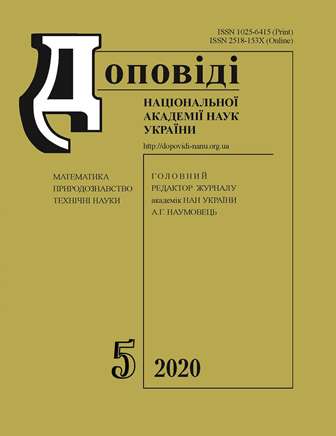Прогнозування біоактивності і синтез нових 3-заміщених 5-тіазолілметиленроданінів
DOI:
https://doi.org/10.15407/dopovidi2020.05.070Ключові слова:
QSAR-аналіз, антибластична активність, молекулярний докінг, роданіни, синтез, тіазолиАнотація
З використанням розроблених регресійної і класифікаційної QSAR-моделей для прогнозування антибластичної активності сполук щодо клітин лінії Hep-2 проаналізовано базу віртуальних структур Z- та E-ізомерних тіазоловмісних похідних N-метил-, N-бензил- і N-фенілетилзаміщених роданінів. Методом молекулярного докінгу оцінено відносну спорідненість 3-заміщених 5-тіазолілметиленроданінів до АТФ-зв’язувального центру потенційної білкової мішені — протеїнкінази Pim-1. За результатами віртуального скринінгу із бази даних відібрано десять сполук, які було синтезовано шляхом взаємодії N-заміщених роданінів з тіазол-2-карбоксальдегідами, тіазол-4-карбоксальдегідами та тіазол-5-карбоксальдегідами. На підставі in vitro досліджень сполук з N-заміщеним роданіновим скафолдом встановлено, що їх цитотоксична дія на культуру клітин аденокарциноми гортані людини Hер-2 у 2,7–10 разів поступається впливу цисплатину як референс-препарату. Найбільш вираженою дією характеризувались роданінова похідна з 5-заміщеним тіазол-2-ільним і N-(4-метоксифеніл)етильним замісниками та сполука з 2-заміщеним тіазол-4-ільним і N-4-метилбензильним замісниками. При цьому їх токсичність, визначена на моделі гідробіонта D. magna, була приблизно на два порядки меншою, ніж у цисплатину.
Завантаження
Посилання
Kaminskyy, D., Kryshchyshyn, A. & Lesyk, R. (2017). Recent developments with rhodanine as a scaffold of drug discovery. Expert Opin. Drug Discov., 12, No. 12, pp. 1233-1252. Doi: https://doi.org/10.1080/17460441.2017.1388370
Sawaguchi, Y., Yamazaki, R., Nishiyama, Y., Sasai, T., Mae, M., Abe, A., Yaegashi, T., Nishiyama, H. & Matsuzaki, T. (2017). Rational design of a potent pan-Pim kinases inhibitor with a rhodanine-benzoimidazole structure. Anticancer Res., 37, No. 8, pp. 4051-4057. Doi: https://doi.org/10.21873/anticanres.11790
Vatolin, S., Phillips, J. G., Jha, B. K., Govindgari, S., Hu J., Grabowski, D., Parker, Y., Lindner, D. J., Zhong, F., Distelhorst, C. W., Smith, M. R., Cotta, C., Xu, Y., Chilakala, S., Kuang, R. R., Tall, S. & Reu, F. J. (2016). Novel protein disulfide isomerase inhibitor with anticancer activity in multiple myeloma. Cancer. Res., 76, No. 11, pp. 3340-3350. Doi: https://doi.org/10.1158/0008-5472.CAN-15-3099
Li, P., Zhang, W., Jiang, H., Li, Y., Dong, C., Chen, H., Zhang, K. & Du, Z. (2018). Design, synthesis and biological evaluation of benzimidazole-rhodanine conjugates as potent topoisomerase II inhibitors. MedChem- Comm., 9, pp. 1194-1205. Doi: https://doi.org/10.1039/C8MD00278A
Bayindir, S., Caglayan, C., Karaman, M. & Gülcin, İ. (2019). The green synthesis and molecular docking of novel N-substituted rhodanines as effective inhibitors for carbonic anhydrase and acetylcholinesterase enzyme. Bioorg. Chem., 90, 103096. Doi: https://doi.org/10.1016/j.bioorg.2019.103096
Bernardo, P.H., Sivaraman, T., Wan, K.-F., Xu, J., Krishnamoorthy, J., Song, C.M., Tian, L., Chin, J.S.F., Lim, D.S.W., Mok, H.Y.K., Yu, V.C., Tong, J.C. & Chai, C.L.L. (2011). Synthesis of a rhodanine-based compound library targeting Bcl-XL and Mcl-1. Pure Appl. Chem., 83, No. 3, pp. 723-731. Doi: https://doi.org/10.1351/PAC-CON-10-10-29
Ozen, C., Unlusoy, M. C., Aliary, N., Ozturk, M. & Dundar, O. B. (2017). Thiazolidinedione or rhodamine: a study on synthesis and anticancer activity comparison of novel thiazole derivatives. J. Pharm. Pharm. Sci., 20, No. 1, pp. 415-427. Doi: https://doi.org/10.18433/J38P9R
Xia, Z., Knaak, C., Ma, J., Beharry, Z. M., Mclnnes, C., Wang, W., Kraft, A. S. & Smith, C. D. (2009). Synthesis and evaluation of novel inhibitors of Pim-1 and Pim-2 protein kinases. J. Med. Chem., 52, No. 1, pp. 74-86. Doi: https://doi.org/10.1021/jm800937p
Zhang, X., Song, M., Kundu, J. K., Lee, M.-H. & Liu, Z.-Z. (2018). PIM kinase as an executional target in cancer. J. Cancer Prev., 23, No. 3, pp. 109-116. Doi: https://doi.org/10.15430/JCP.2018.23.3.109
Choi, J. L., Cho, S. I., Do, N. Y., Kang, C. Y. & Lim, S. C. (2010). Clinical significance of the expression of galectin-3 and Pim-1 in laryngeal squamous cell carcinoma. J. Otolaryngol. Head Neck Surg., 39, No. 1, pp. 28-34.
Morris, G. M., Goodsell, D. S., Halliday, R. S., Huey, R., Hart, W. E., Belew, R. K. & Olson, A. J. (1998). Automated docking using a Lamarckian genetic algorithm and an empirical binding free energy function. J. Comput. Chem., 19, No. 14, pp. 1639-1662. Doi: https://doi.org/10.1002/(SICI)1096-987X(19981115)19:14<1639::AID-JCC10>3.0.CO;2-B
Pogacic, V., Bullock, A. N., Fedorov, O., Filippakopoulos, P., Gasser, C., Biondi, A., Meyer-Monard, S., Knapp, S. & Schwaller, J. (2007). Structural analysis identifies imidazo[1,2-b]pyridazines as PIM kinase inhibitors with in vitro antileukemic activity. Cancer Res., 67, No. 14, pp. 6916-6924. Doi: https://doi.org/10.1158/0008-5472.CAN-07-0320
Berman, H. M., Westbrook, J., Feng, Z., Gilliland, G., Bhat, T. N., Weissig, H., Shindyalov, I. N. & Bourne, P. E. (2000). The Protein Data Bank. Nucleic Acids Res., 28, No. 1, pp. 235-242. Doi: https://doi.org/10.1093/nar/28.1.235
Hanwell, M. D., Curtis, D. E., Lonie, D. C., Vandermeersch, T., Zurek, E. & Hutchison, G. R. (2012). Avogadro: an advanced semantic chemical editor, visualization, and analysis platform. J. Cheminform., 4, No. 1, 17. Doi: https://doi.org/10.1186/1758-2946-4-17
Sanner, M. F. (1999). Python: a programming language for software integration and development. J. Mol. Graph. Model., 17, pp. 57-61.
##submission.downloads##
Опубліковано
Як цитувати
Номер
Розділ
Ліцензія
Авторське право (c) 2023 Доповіді Національної академії наук України

Ця робота ліцензується відповідно до Creative Commons Attribution-NonCommercial 4.0 International License.




